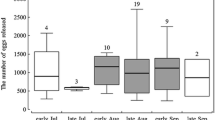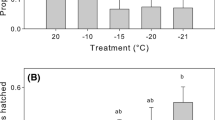Abstract
Notonecta unifasciata Guerin eggs maintained at different stages of embryonic development in water at variable temperatures (2.2–25.6 °C) and for periods of 4–12 weeks revealed maximum viability (>80 %) at the highest temperature. However, optimum nondevelopmental viability was at 14.4 °C with eight-day-old embryos (>35 %). Short term (4 weeks) storage at 14.4 °C significantly increased egg viability. Survival was poor (<20 %) at the 2 lowest temperatures. Eggs held at 14.4 °C for 12 weeks and sustainingca. 50 % mortality, may be a practical procedure for biological control.
Résumé
Les œufs deNotonecta unifasciata Guérin à différents stades de développment embryonnaire maintenus dans l'eau à des températures variables (2,2–25 °C) et durant de 4 à 12 semaines révèlent une viabilité maximale (>80 %) à la température la plus forte. Cependant, la viabilité optimale sans développement se situait à 14.4 °C avec des embryons âgés de 8 jours (>35 %). Un court stockage (4 semaines) à 14.4 °C augmente d'une façon significative la viabilité de l'œuf. La survie était faible (<20 %) aux 2 températures les plus basses.
Des œufs maintenus à 14.4 °C durant 12 semaines et supportant environ 50 % de mortalité peuvent être un procédé pratique de lutte biologique.
Resúmen
Huevecillos deNotonecta unifasciata mantenidos en varios estadios del desarrollo embrionarios y a varias temperaturas (2.2–25.6 °C) por 4–12 semanas, demostraron la mayor viabilidad (>80 %) a la temperatura más alta. Sín embargo, la óptima viabilidad cuando no hubo desarrollo, se realizó en embriones de ocho días de edad, mantenidos a 14.4 °C. Almacenamiento de corto tiempo (cuatro semanas) a 14.4 °C se produjo un significante aumento de viabilidad. Superviviencia fué baja (<20 %) a temperaturas menos de 8.3 °C. Se ofrece que huevecillos almacenados a 14.4 °C por 12 semanas, cuales se realizan un 50 % mortalidad, puede servir en la ejecución del control biológico.
Similar content being viewed by others
References
Bare, C. O. — 1926. Life histories of some Kansas backswimmers. —Ann. Entomol. Soc. Am., 19, 93–101.
Bay, E. C. — 1967. Potential for naturalistic control of mosquitoes. —Proc. Calif. Mosq. Control Assoc., 35, 34–37.
Clark, I. B. — 1928. Seasonal distribution and life history ofNotonecta undulata in the Winnipeg region, Canada. —Ecology, 9, 383–403.
Ellis, R. A. &Borden, J. H. — 1969a. Effects of temperature and other environmental factors onNotonecta undulata Say [Hemiptera: Notonectidae]. —Pan-Pacific Entomol., 45, 20–25.
Ellis, R. A. &Borden, J. H. — 1969b. Laboratory rearing ofNotonecta undulata Say [Hemiptera: Notonectidae]. —J. Entomol. Soc. Brit. Columbia, 66, 51–53.
Ellis, R. A. &Borden, J. H. — 1970. Predation byNotonecta undulata [Heteroptera: Notonectidae] on larvae of the yellow-fever mosquito. —Ann. Entomol. Soc. Am., 63, 963–973.
Hazelrigg, J. E. — 1973. Investigations of the biology and predatory capacity ofNotonecta unifasciata Guerin [Hemiptera: Notonectidae]. — PhD. Dissertaiton, Univ. of Calif., 135 p.
Hess, A. D. &Tarzwell, C. M. — 1942. The feeding habits ofGambusia affinis affinis, with special reference to the malaria mosquito,Anopheles quadrimaculatus. —Am. J. Hyg., 35, 142–151.
Hoy, J. B. &O'Berg, A. G. — 1972. The theoretical aspects of a large-scale field test of rice field mosquito control. —Proc. Calif. Mosq. Control Assoc., 40, 119–120.
Hoy, J. B., O'Berg, A. G. &Kauffman, E. E. — 1971. The mosquitofish as a biological control agent againstCulex tarsalis andAnopheles freeborni in Sacramento Valley rice fields. —Mosq. News, 31, 146–152.
Hungerford, H. B. — 1917. The life history of the backswimmer,Notonecta undulata Say [Hem.: Het.]. —Entomol. News. 28, 266–277.
Jenkins, D. W. — 1964. Pathogens, parasites and predators of medically important arthropods. Annotated list and bibliography. —Bull. Wld. Hlth. Organ. Suppl., 150 p.
Legner, E. F. &Sjogren, R. D. — 1984. Biological mosquito control furthered by advances in technology and research. —J. Am. Mosq. Control Assoc., 44, 449–456.
Rice, L. A. — 1941.Gambusia affinis in relation to food habits from Reelfoot Lake, 1940, with special emphasis on malaria control. —J. Tenn. Acad. Sci., 16, 77–87.
Steel, G. D. &Torrie, J. H. — 1960. Principles and procedures of statistics. —McGraw-Hill Book Co., Inc., N. Y., 481 p.
Toth, R. S. &Chew, R. M. — 1972. Development and energetics ofNotonecta undulata during predation onCulex tarsalis. —Ann. Entomol. Soc. Am., 65, 1270–1279.
Washino, R. K. &Hokama, Y. — 1967. Preliminary report on the feeding pattern of two species of fish in a rice field habitat. —Proc. Calif. Mosq. Control Assoc., 35, 84–87.
Author information
Authors and Affiliations
Rights and permissions
About this article
Cite this article
Sjogren, R.D., Legner, E.F. Survival of the mosquito predator,Notonecta unifasciata[Hemiptera: Notonectidae] embryos at low thermal gradients. Entomophaga 34, 201–208 (1989). https://doi.org/10.1007/BF02372669
Received:
Accepted:
Issue Date:
DOI: https://doi.org/10.1007/BF02372669




